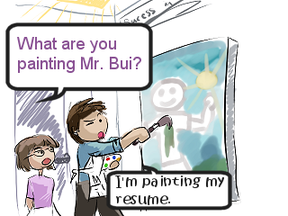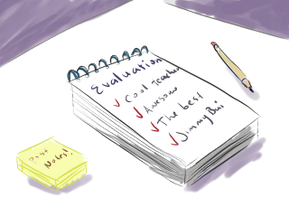PROFESSIONAL QUALIFICATIONS AND INFORMATION
|
The following sections are a quick professional representation of how I look at a glance as a possible teacher candidate. The section includes a teaching resume and recommendation letters given to me by professors, my master teacher from my student teaching, and the principal where I was student teaching. The content of these materials covers materials since I have enrolled in the teaching and master program and the University of San Francisco in the fall of 2009.
|
RESUME
|
I graduated with a Masters in Teaching in the spring of 2011 at the University of San Francisco. With the completion of the program, I hold a masters degree in teaching, and two credentials as well. My single subject credential is in science. My exposure to schoolage children range from as early as preschool all the way through high school, with my most recent experience in upper elementary. Teaching is not an easy career and requires one to be able to adapt and deal with several factors of educating children. It requires the teacher to be an actor, be witty, flexible, compassionate, understanding, and essentially to be a human being. These are traits that any child can explain about their most favorite teacher, because the person who teaches is the one that makes learning worth while, even if they may not remember the content.
As an educator I am always looking for new inspirations to paint my teaching canvas. I simply do not just teach from a script, but I teach with an eye to add to an unfinished masterpiece that motivates and intrigues children to participate and desire to learn intrinsically. However, not teaching from a script does not mean being disorganized and chaotic. It simply means my approach comes from a different perspective where the children are exposed to a well thought out lesson that has several key elements such as various assessments to check for understanding, periods of transitions, and a clear process from start to finish where the students end up doing a majority of independent practice. |
FILE ATTACHMENTS:
1. Current Teaching Resume
This is my teaching resume and covers areas of teaching that is directly related to instructing children in some form.
1. Current Teaching Resume
This is my teaching resume and covers areas of teaching that is directly related to instructing children in some form.
TEACHING EVALUATIONS
|
During our student teaching, we are observed for a total of nine times to assess if we are able to effectively teach and meet the Teaching Performance Expectations (TPE). The lessons are written up in taskstream and each lesson is judged on the main focus of the lesson, if the goals and objectives were achieved, and if the student teacher was able to reflect upon their teaching.
|
FILE ATTACHMENTS:
1. Observation 01 - Student Teaching I - 1st Grade
This is an observation in which I created an all encompassing lesson learning on silent-e for kindergartners entering into first grade. The lesson involves effective use of the classroom and captivating and motivating the student through their imagination, a play based learning strategy.
2. Observation 02 - Student Teaching II - 5th Grade
This is a science observation on the water cycle. The students will watch and observe the water cycle in a controlled system small enough for them to observe. After the lab, the students will watch a cartoon clip on the water cycle and create a comic about the water cycle.
3. Observation 03 - Student Teaching II - 5th Grade
Decimal and division are concepts that are very difficult for children at this age. By not having an activity that makes it meaningful, then the students will have no reason for learning the material. This is a lesson observation where students are using their knowledge of decimals and division to exchange currency with a bank system (me).
4. Observation 04 - Student Teaching II - 5th Grade
The distributive property is an abstract concept that most students do not understand why it works. During this observation, I had the students use various manipulatives to represent numbers and variables. Using the simple process of re-arranging the groups and shapes, the students were able to visually do the distributive property.
5. Observation 05 - Student Teaching II - 5th Grade
Students are now having a cross subject lesson where they are learning about Native Americans, reading a story about Native Americans and the Westward Expansion, and have formed groups that will require the tribe to create myths that are based on the structures of real Native American myths and folklore. The observation was was for the period before the students collaborated together to make a myth, and is learning to dissect what a myth looks like.
6. Observation 06 - Student Teaching II - 5th Grade
There are two main focus for this observation, the first use of the jigsaw strategy and a review of the unit section on weather. This lesson utilizes a new learning strategy for the students whom have never observed or tried the technique before. The review went well and the assessment scores showed fair result changes from the students who benefited most from group work.
7. Observation 07 - Student Teaching III - 5th
This observation was by Dr. Fenderson who saw the students use fraction strips to compare, order, and sort fractions. The students were given a method to visually see and compare fractions where it was not in the form of a circle.
8. Observation 08 - Student Teaching III - 5th
This observed lesson was about the usage of technology in order to create a poem known as a reverso poem. Due to the fact that the students were unfamiliar with writing poetry a second segment where the students go online to respond to each other was modified to students typing and moving around to read each other's poem on screen.
9. Observation 09 - Student Teaching III - 5th Grade
The last of my observation was a Language Arts lesson. This was a borrowed lesson from a classmate that I heavily modified to reflect my teaching style. The lesson in my opinion went extremely smooth and everything went perfectly well.
1. Observation 01 - Student Teaching I - 1st Grade
This is an observation in which I created an all encompassing lesson learning on silent-e for kindergartners entering into first grade. The lesson involves effective use of the classroom and captivating and motivating the student through their imagination, a play based learning strategy.
2. Observation 02 - Student Teaching II - 5th Grade
This is a science observation on the water cycle. The students will watch and observe the water cycle in a controlled system small enough for them to observe. After the lab, the students will watch a cartoon clip on the water cycle and create a comic about the water cycle.
3. Observation 03 - Student Teaching II - 5th Grade
Decimal and division are concepts that are very difficult for children at this age. By not having an activity that makes it meaningful, then the students will have no reason for learning the material. This is a lesson observation where students are using their knowledge of decimals and division to exchange currency with a bank system (me).
4. Observation 04 - Student Teaching II - 5th Grade
The distributive property is an abstract concept that most students do not understand why it works. During this observation, I had the students use various manipulatives to represent numbers and variables. Using the simple process of re-arranging the groups and shapes, the students were able to visually do the distributive property.
5. Observation 05 - Student Teaching II - 5th Grade
Students are now having a cross subject lesson where they are learning about Native Americans, reading a story about Native Americans and the Westward Expansion, and have formed groups that will require the tribe to create myths that are based on the structures of real Native American myths and folklore. The observation was was for the period before the students collaborated together to make a myth, and is learning to dissect what a myth looks like.
6. Observation 06 - Student Teaching II - 5th Grade
There are two main focus for this observation, the first use of the jigsaw strategy and a review of the unit section on weather. This lesson utilizes a new learning strategy for the students whom have never observed or tried the technique before. The review went well and the assessment scores showed fair result changes from the students who benefited most from group work.
7. Observation 07 - Student Teaching III - 5th
This observation was by Dr. Fenderson who saw the students use fraction strips to compare, order, and sort fractions. The students were given a method to visually see and compare fractions where it was not in the form of a circle.
8. Observation 08 - Student Teaching III - 5th
This observed lesson was about the usage of technology in order to create a poem known as a reverso poem. Due to the fact that the students were unfamiliar with writing poetry a second segment where the students go online to respond to each other was modified to students typing and moving around to read each other's poem on screen.
9. Observation 09 - Student Teaching III - 5th Grade
The last of my observation was a Language Arts lesson. This was a borrowed lesson from a classmate that I heavily modified to reflect my teaching style. The lesson in my opinion went extremely smooth and everything went perfectly well.



